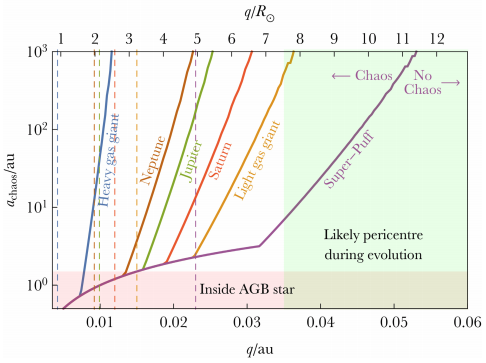The dynamical history and current orbital constraints of a milestone ice giant planet orbiting a white dwarf
- 1Centre for Exoplanets and Habitability, University of Warwick, Coventry CV4 7AL, UK
- 2Department of Physics, University of Warwick, Coventry CV4 7AL, UK
- 3TAPIR, Mailcode 350-17, California Institute of Technology, Pasadena, CA 91125, USA
Robust evidence of an ice giant planet shedding its atmosphere around the white dwarf WD J0914+1914 represents a milestone in exoplanetary science, allowing us to finally supplement our knowledge of white dwarf debris discs, minor planets and metal pollution with the presence of a major planet.
Here, I discuss the possible dynamical origins of this planet, WD J0914+1914 b. The very young cooling age of the host white dwarf (13 Myr) combined with the currently estimated planet-star separation of about 0.07 au imposes particularly intriguing and restrictive coupled constraints on its current orbit and its tidal dissipation characteristics. The planet must have been scattered from a distance of at least a few au to its current location, requiring the current or former presence of at least one more major planet in the system in the absence of a hidden binary companion. I show that WD J0914+1914 b could not have subsequently shrunk its orbit through chaotic f-mode tidal excitation (characteristic of such highly eccentric orbits) unless the planet was or is highly inflated and possibly had partially thermally self-disrupted from mode-based energy release. I also demonstrate that if the planet is currently assumed to reside on a near-circular orbit at 0.07 au, then non-chaotic equilibrium tides impose unrealistic values for the planet's tidal quality factor. I conclude that WD J0914+1914 b either (i) actually resides interior to 0.07 au, (ii) resembles a disrupted `Super-Puff' whose remains reside on a circular orbit, or (iii) resembles a larger or denser ice giant on a currently eccentric orbit. Distinguishing these three possibilities strongly motivates follow-up observations.
I will also analyse the prospects for exterior extant rocky asteroids, boulders, cobbles, and pebbles to radiatively drift inward past the planet due to the relatively high luminosity of this particularly young white dwarf, and I will place stability bounds on the gas disc formed from the planet's evaporated atmosphere.

Caption: Demonstration that WD J0914+1914 b was very unlikely to have experienced high-eccentricity chaotic tidal evolution unless the planet is or was a highly inflated Super-Puff. The solid curves represent the minimum initial semimajor axes (y-axis) for which different types of planets would have experienced chaotic tidal evolution around the white dwarf for given orbital pericentres (x-axes). The vertical dashed lines are representative white dwarf tidal disruption radii for each type of planet, ordered from left to right in the same way as the solid curves. Because Super-Puffs are particularly vunerable to self-disruption through chaotic tides, current observations may be of a partially or fully disrupted ice giant.
How to cite: Veras, D. and Fuller, J.: The dynamical history and current orbital constraints of a milestone ice giant planet orbiting a white dwarf, Europlanet Science Congress 2020, online, 21 September–9 Oct 2020, EPSC2020-239, https://doi.org/10.5194/epsc2020-239, 2020

